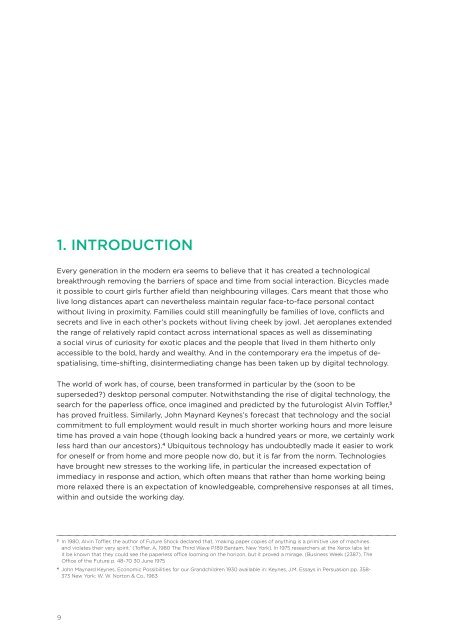Trends and Friends: Access, use and benefits of digital technology for homeless and ex-homeless people
You also want an ePaper? Increase the reach of your titles
YUMPU automatically turns print PDFs into web optimized ePapers that Google loves.
1. INTRODUCTION<br />
Every generation in the modern era seems to believe that it has created a technological<br />
breakthrough removing the barriers <strong>of</strong> space <strong>and</strong> time from social interaction. Bicycles made<br />
it possible to court girls further afield than neighbouring villages. Cars meant that those who<br />
live long distances apart can nevertheless maintain regular face-to-face personal contact<br />
without living in proximity. Families could still meaningfully be families <strong>of</strong> love, conflicts <strong>and</strong><br />
secrets <strong>and</strong> live in each other’s pockets without living cheek by jowl. Jet aeroplanes <strong>ex</strong>tended<br />
the range <strong>of</strong> relatively rapid contact across international spaces as well as disseminating<br />
a social virus <strong>of</strong> curiosity <strong>for</strong> <strong>ex</strong>otic places <strong>and</strong> the <strong>people</strong> that lived in them hitherto only<br />
accessible to the bold, hardy <strong>and</strong> wealthy. And in the contemporary era the impetus <strong>of</strong> despatialising,<br />
time-shifting, disintermediating change has been taken up by <strong>digital</strong> <strong>technology</strong>.<br />
The world <strong>of</strong> work has, <strong>of</strong> course, been trans<strong>for</strong>med in particular by the (soon to be<br />
superseded?) desktop personal computer. Notwithst<strong>and</strong>ing the rise <strong>of</strong> <strong>digital</strong> <strong>technology</strong>, the<br />
search <strong>for</strong> the paperless <strong>of</strong>fice, once imagined <strong>and</strong> predicted by the futurologist Alvin T<strong>of</strong>fler, 3<br />
has proved fruitless. Similarly, John Maynard Keynes’s <strong>for</strong>ecast that <strong>technology</strong> <strong>and</strong> the social<br />
commitment to full employment would result in much shorter working hours <strong>and</strong> more leisure<br />
time has proved a vain hope (though looking back a hundred years or more, we certainly work<br />
less hard than our ancestors). 4 Ubiquitous <strong>technology</strong> has undoubtedly made it easier to work<br />
<strong>for</strong> oneself or from home <strong>and</strong> more <strong>people</strong> now do, but it is far from the norm. Technologies<br />
have brought new stresses to the working life, in particular the increased <strong>ex</strong>pectation <strong>of</strong><br />
immediacy in response <strong>and</strong> action, which <strong>of</strong>ten means that rather than home working being<br />
more relaxed there is an <strong>ex</strong>pectation <strong>of</strong> knowledgeable, comprehensive responses at all times,<br />
within <strong>and</strong> outside the working day.<br />
3<br />
In 1980, Alvin T<strong>of</strong>fler, the author <strong>of</strong> Future Shock declared that, ‘making paper copies <strong>of</strong> anything is a primitive <strong>use</strong> <strong>of</strong> machines<br />
<strong>and</strong> violates their very spirit.’ (T<strong>of</strong>fler, A, 1980 The Third Wave P.189 Bantam, New York). In 1975 researchers at the Xerox labs let<br />
it be known that they could see the paperless <strong>of</strong>fice looming on the horizon, but it proved a mirage. (Business Week (2387), The<br />
Office <strong>of</strong> the Future p. 48–70 30 June 1975<br />
4<br />
John Maynard Keynes, Economic Possibilities <strong>for</strong> our Gr<strong>and</strong>children 1930 available in: Keynes, J.M, Essays in Persuasion pp. 358-<br />
373 New York: W. W. Norton & Co., 1963<br />
9

















